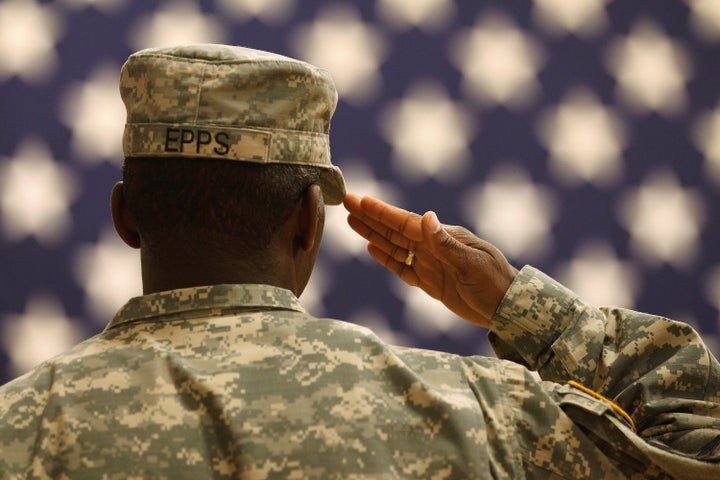
New York City, N.Y. (November 11, 2011) -- With freshly shaved heads, and wearing a military uniform for the first time, they raised their right hands. Together, they swore to protect the Constitution against all enemies, foreign and domestic; affirming their decision to support our country. They are the 1%; those who've been engaged in the wars since 9/11.
In the past decade, the military has grown in size to support two wars on foreign soil and fighting terrorism across the globe. As the al Qaeda leadership are killed, and our presence in Iraq dwindles, so does the personnel needed to augment this 10 year military campaign. Our defense budget is winnowing and our military manpower is decreasing. As a result, veterans are flooding the workforce to join the ranks of the 99% and are looking for jobs.
These economic times are tenuous. The challenge of unemployment plagues our nation with a consistent 9 percent rate. While staggering, it is even worse with our veteran population. The Bureau of Labor and Statistics listed veteran unemployment at 2 percentage points higher than the national average in 2011. For our service members who have fought in Afghanistan and Iraq it has climbed to over a staggering 20 percent. Without an understanding of how a military member can enhance an organization, veteran unemployment will continue to rise.
These statistics are hard to stomach, knowing that many of our veterans have skills that easily correlate to the civilian workforce. Whether it is communications, logistics, intelligence, medical or engineering, to name only a few, veterans have been tested in dynamic circumstances and relied on their training to accomplish various missions. The issue, it seems, is that military jobs and accomplishments aren't readily understood by the civilian world. To bridge this gap, our policy makers in Congress and the Senate have introduced legislature to better educate the public on the value added to a business by hiring a veteran. They have also established other initiatives to curtail the number of unemployed service members. With increased awareness and synergy of effort from our political leaders and both the private and public sectors, we can mitigate this veteran unemployment epidemic.
There are two pieces of legislature coming from Washington. The Hire Heroes Act invests in a study that would effectively translate military skills to civilian equivalents. The Veterans Opportunity to Work Act intends to catalyze veteran employment, training and job placement. Additionally, this past August the president unveiled a strategy providing tax breaks to organizations which hire veterans.
The White House proposals, similar to other initiatives discussed in Congress in recent years, would provide businesses a $2,400 tax credit for hiring any unemployed veteran, a $4,800 tax credit for hiring a veteran who has been out of work for at least six months, and a $9,600 tax credit for hiring a veteran with a service-connected disability who has been out of work for six months. Furthermore, the post 9/11 GI Bill has been tremendous in providing the possibility of higher education to prepare our servicemen and women for job opportunities. The original GI Bill was instrumental in the lives of our "greatest generation," enabling them to pursue higher education, enter and contribute to the workforce, and spark the economic boom of that era.
However, just like a military operation, it needs to be a joint effort and we cannot rely on policies from Washington alone. There are other "weapons" in our arsenal that help communicate how a veteran would fortify any corporation, thereby creating public awareness and enabling the skills our veterans have garnered in training and combat. Helmets to Hard Hats connects veterans with promising careers in construction fields. Feds Hire Vets helps military personnel find jobs in the federal government. The Veterans on Wall Street initiative is dedicated to facilitating former military personnel with business opportunities in the financial service industry.
While these are very specific, there are also organizations like VETSagency.com that offer transitional services for life after the military in a variety of fields. Furthermore, there are nonprofit organizations that offer other various opportunities and intermediary services like Wall Street War Fighters, Travis Manion Foundation, Iraq and Afghanistan Veterans of America, and Hire Heroes USA.
Since taking that first oath, the government has invested hundreds of thousands of dollars in training service members for the most complex and challenging scenarios. These men and women are defined by a shared code of conduct, world-class training tested and proven in the most volatile environments. Leadership, discipline, decisiveness, accountability and ingenuity are a few of the skills taught and required for success in the "University of the U.S. Military." The moral and ethical standards, the harsh training conditions, and the unforgiving world of combat where risk and gain can equal life and death have prepared our military for future leadership in and out of the service. The skills acquired in this unique environment make veterans an incredible resource that would enhance any organization.
As the tempo of combat operations changes, our veterans return home exchanging cammies and boots for suits and hardhats. Military alum are confident leaders who will become pillars of the business, government, and federal world. Don't hire a veteran because you think you are doing them a favor; hire a veteran because you are doing yourself a favor.
The views presented are those of the author and do not necessarily represent the views of the Department of Defense, the Department of the Navy or the United States Marine Corps.